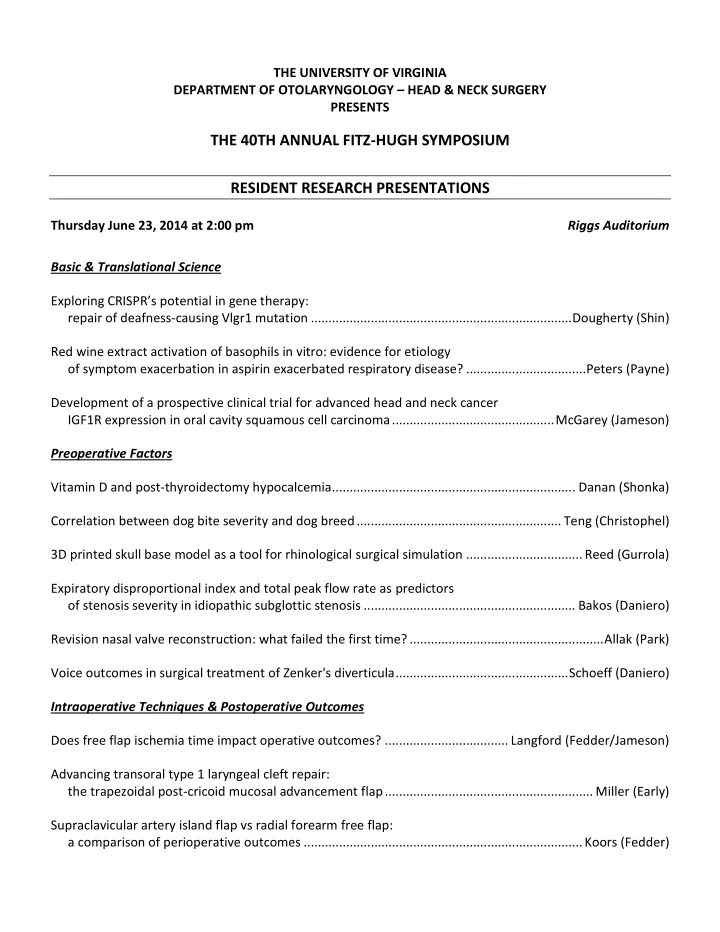

THE UNIVERSITY OF VIRGINIA DEPARTMENT OF OTOLARYNGOLOGY – HEAD & NECK SURGERY PRESENTS THE 40TH ANNUAL FITZ-HUGH SYMPOSIUM RESIDENT RESEARCH PRESENTATIONS Thursday June 23, 2014 at 2:00 pm Riggs Auditorium Basic & Translational Science Exploring CRISPR’s potential in gene t herapy: repair of deafness-causing Vlgr1 mutation .......................................................................... Dougherty (Shin) Red wine extract activation of basophils in vitro: evidence for etiology of symptom exacerbation in aspirin exacerbated respiratory disease? .................................. Peters (Payne) Development of a prospective clinical trial for advanced head and neck cancer IGF1R expression in oral cavity squamous cell carcinoma .............................................. McGarey (Jameson) Preoperative Factors Vitamin D and post-thyroidectomy hypocalcemia ..................................................................... Danan (Shonka) Correlation between dog bite severity and dog breed .......................................................... Teng (Christophel) 3D printed skull base model as a tool for rhinological surgical simulation ................................. Reed (Gurrola) Expiratory disproportional index and total peak flow rate as predictors of stenosis severity in idiopathic subglottic stenosis ............................................................ Bakos (Daniero) Revision nasal valve reconstruction: what failed the first time? ....................................................... Allak (Park) Voice outcomes in surgical treatment of Zenker's diverticula ................................................. Schoeff (Daniero) Intraoperative Techniques & Postoperative Outcomes Does free flap ischemia time impact operative outcomes? ................................... Langford (Fedder/Jameson) Advancing transoral type 1 laryngeal cleft repair: the trapezoidal post-cricoid mucosal advancement flap ........................................................... Miller (Early) Supraclavicular artery island flap vs radial forearm free flap: a comparison of perioperative outcomes ............................................................................... Koors (Fedder)
RESIDENT RESEARCH ABSTRACTS Explor ing CRISPR’s potential in gene t herapy: repair of deafness-causing Vlgr1 mutation William Dougherty MD; Jung-Bum Shin PhD; Tingting Du PhD Objective: The goal of this project is to repair deafness-causing mutations in the mouse, using the Clustered Regularly Interspaced Palindromic Repeat (CRISPR)/Cas-mediated genome editing technology, which allows targeted genetic modification of virtually any locus of interest. Design, Subjects, and Interventions: In this project, we target a deafness causing mutation in the VLGR1 gene. Mutations in VLGR1, (very large g-protein receptor), are known to cause profound deafness. The overall strategy of this project is to repair the mutation in vivo, by delivering CRISPR/Cas components to inner ear hair cells using an adeno-associated virus (AAV) vector system. The first objective is to demonstrate expression of the CRISPR/Cas components in the hair cells, and the second to demonstrate repair of the targeted gene locus and restoration of hearing. Success of the project will be assessed by monitoring the expression of CRISPR/Cas components and the repair of the gene locus in vitro and in vivo, as well as restoration of protein expression, hair cell morphology, and hearing function. Results: In the initial stages of the project we demonstrate the feasibility of a novel technique and study design. Specifically, demonstrating CRISPR/Cas 9 expression in wild type mice pups after AAV injection into the inner ear in the first few days of life. The procedure in wild type mice does not appear to cause inner ear trauma sufficient to result in a permanent hearing loss. Additionally, genotyping of in vitro explant cochlea also demonstrate gene editing at the targeted sequence. Conclusions: Delivery of CRISPR/Cas components to the mouse inner ear via a viral vector is a feasible approach for repair of genetic hearing loss. Future efforts for this project will explore additional mutations for inner ear proteins, as hearing restoration with this approach likely depends on the critical period during which a protein is necessary for appropriate morphologic organization and creation of a functional mechanotransduction system in the hair cell. Red wine extract activation of basophils in-vitro: evidence for etiology of symptom exacerbation in aspirin exacerbated respiratory disease? Daniel Peters MD ; Julie Negri MS; John Steinke PhD; Larry Borish MD; Spencer Payne MD Objective: To explore the mechanisms of symptomatic exacerbation of patients with AERD on exposure to red wine Design: In-vitro analysis of granulocyte activation Subjects: Whole blood samples were obtained from patients without asthma (n=3), patients with asthma (n=3), and patients with aspirin sensitive asthma (n=1). Intervention: Whole blood isolates and purified granulocyte populations were obtained from patients with asthma and healthy controls. These were exposed to components of red wine including ethanol, red wine extract and a representative polyphenolic compound, resveratrol. Markers of granulocyte activation were then measured via flow cytometry and ELISA for basophils and eosinophils respectively. Additionally, culture derived mast cells were also tested via ELISA. Results: Exposure to red wine extract resulted in activation of basophils in all samples. Mean basophil florescence increased from a baseline of 4.2 to 8.4 following exposure to red wine extract. This was not seen with ethanol or resveratrol, nor was activation detected in mast cells (via PGD2) or eosinophils (via EDN) with any compound. Conclusion: One mechanism for symptom exacerbation with exposure to red wine appears to be through basophil activation via the non-alcoholic components of red wine. This does not appear to be secondary to resveratrol. Additional studies with other phenolic compounds will need to be performed. 2
Recommend
More recommend